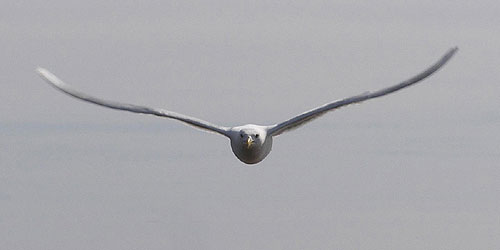 Alaska Science
Gulls love garbage
Alaska Science
Gulls love garbage
By NED ROZELL
March 18, 2010
Thursday
Garbage allows gulls to thrive in the oilfields of northern Alaska,
and furry little pikas might be changing their body shapes in
response to changes in climate, according to two graduate students
who recently gave public defenses of their theses at the University
of Alaska Fairbanks.
 A glaucous gull summering
on Alaska's North Slope.
A glaucous gull summering
on Alaska's North Slope.
Photo by Emily Weiser
Emily Weiser spent a few summers on Alaska's North Slope, studying
glaucous gulls, creamy white and gray birds most people refer
to as "seagulls." The birds spend their summers off
the north coast of Alaska and inland up to about 100 miles.
Weiser studied gulls at Barrow, Alaska's northernmost city; at
Cape Simpson, where no people live; at Alpine oil field, in the
North Slope's Colville River Delta; and at Deadhorse, a town
just south of Prudhoe Bay. She wanted to see if the presence
of available garbage enhanced the population of glaucous gulls,
which eat just about everything, including the eggs and chicks
of other birds.
"Glaucous gulls are the most abundant human-subsidized predator
(in the oilfield area)," Weiser said.
She teased apart pellets the gulls had coughed up to look for
the presence of plastic. The birds around Deadhorse - where there
is an open landfill, unlike Barrow and the Alpine oil field,
where garbage is incinerated - had a huge percentage of garbage
in their diets. Using those results and some statistical analysis,
she concluded that birds with access to open garbage dumps seemed
to be doing better than others. For instance, garbage-consuming
groups of gulls experienced higher fledgling success.
Weiser mentioned a study in which researchers found that only
about four out of 10 gull chicks migrate back to the same area
in which they were born. Without human-related sources of food,
the wayward birds might be hitting the eggs and young of other
birds, such as black brant, northern pintails, arctic terns,
and shorebirds.
This column is provided
as a public service by the Geophysical
Institute, University of Alaska Fairbanks, in cooperation
with the UAF research community.
Ned Rozell [nrozell@gi.alaska.edu]
is a science writer at the institute.
E-mail your news &
photos to editor@sitnews.us
Publish A Letter in SitNews Read Letters/Opinions
Contact the Editor
SitNews
©2010
Stories In The News
Ketchikan, Alaska
|



